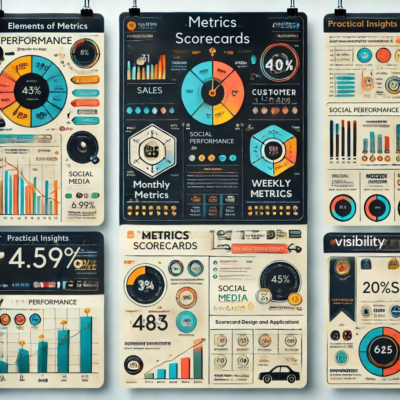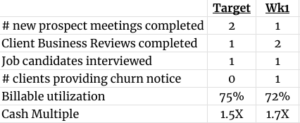Examples of Metrics Scorecards – Week #23 of The Financial Operating System®

Prior notes have mentioned using metrics scorecards. This weekly note summarizes Chapter 9 and provides examples of weekly, monthly, and quarterly scorecards, each tailored to align with specific business objectives and timeframes.
Key Elements of Metrics Scorecards:
Weekly Metrics:
-
- Focus: Activity-based and leading indicators.
- Purpose: Ensure future results by monitoring behaviors and efforts that drive longer-term success.
- Standard-Based Management: Employees are expected to meet weekly standards to align their actions with company objectives. If standards are not met, corrective actions are required.
- Example:

Monthly Metrics:
-
- Focus: A mix of leading and lagging indicators.
- Purpose: Evaluate progress toward quarterly and annual objectives while reflecting on recent performance.
- Example:

Quarterly Metrics:
-
- Focus: Primarily lagging indicators, providing a review of the period’s overall performance.
- Purpose: Track progress toward annual financial goals and completion of strategic projects.
- Example:

Sequential Metrics Alignment:
-
- Weekly achievements contribute to monthly metrics, which in turn align with quarterly and annual objectives.
- This cascading approach ensures consistency and focus across all levels of the organization.
Scorecard Design and Application:
-
- Metrics should be clear, relevant, and manageable. Overloading scorecards with excessive metrics can dilute focus.
- Tailor metrics to the department or team responsible for them. For example:
- Sales teams focus on revenue and customer acquisition metrics.
- Service departments prioritize quality, utilization, and satisfaction metrics.
Iterative Process:
Metrics and targets should evolve based on experience and business needs. Scorecard usage will reveal areas for adjustment and improvement.
Regular review and refinement ensure that metrics remain aligned with strategic goals.
Practical Insights:
Metrics scorecards are vital for translating strategic objectives into actionable plans and measurable outcomes. They provide visibility into performance, create accountability, and help managers make data-driven decisions.
Next Step:
Business owners can self-implement The Financial Operating System. Chapters are available to download at smartbooks.com/resources or you can buy the whole book from Amazon (the marketing firm version or the general business version).
If you would like assistance with implementation or would like to accelerate results for your business, please contact author Cal Wilder at cwilder@smartbooks.com or book a free consultation with our team directly using this calendar link.